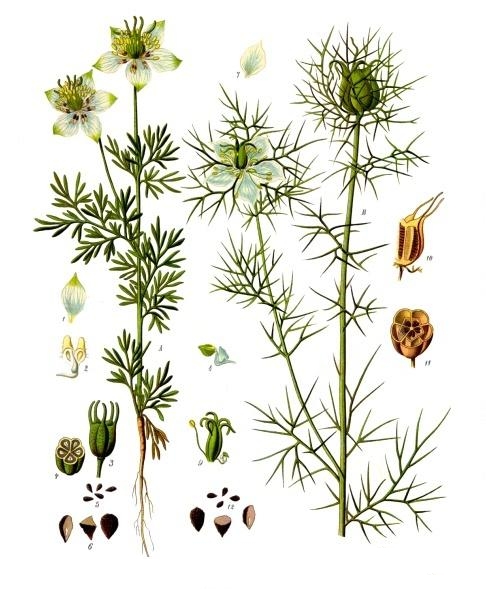Plants and the chemicals they make: black cumin oil (Nigella sativa)
We get attracted to plant extracts for many reasons. Besides advertising, there are cultural influences (what did your grandmother use when you were sick?), the attraction of the exotic (if it is Korean, it must be better), and even the common name of the plant (dragon’s blood, anybody?).
As a scientist, I have to be more careful with how I choose plant extracts as an ingredient for our Skin Actives products. Yes, I look at plants that were used for centuries by different peoples. I read the publications that deal with the ethnological use of the plant extracts, but that is only the beginning. Maybe the ancient people who used plant X used it because there was nothing else around. Are there any modern reports of benefits? How good are those papers? The scientific literature is full of rubbish and you need to look at the Materials and Methods section before you look at anything else (some people take the title of a paper as evidence!). Then, if any benefits can be attributed to the extracts, the next step is to find out the chemical composition of the beneficial extract and which are the components that are responsible for that benefit. The last step, and one that is always in progress, is to explore the mechanism of action of the component. How does the chemical interact with our body in order to provide the benefit?
I love it when the mechanism of action is elucidated, even if only partially. Then, the beauty of science is there in all its glory, like with apocynin. This does not mean that we know “the truth”. Science is about checking and rechecking.
Let’s check where in this long road we are with black cumin oil, pressed from the seeds of Nigella sativa. Black cumin oil was used in Biblical times and is still used in Ayurvedic medicine. For the skin, it has been used for psoriasis.
The oil does not smell “plain”. Why not? Besides the usual fatty acids, it also contains some aromatic chemicals that make black cumin a spice used in the cuisine of Egypt and Turkey.
The oil contains fatty acids like linoleic acid (50%), oleic acid (20%), pamitic acid, and cis-11,14-eicosadienoic acid (8%). These are nice fatty acids. But don’t choose black cumin oil because of the fatty acids it contains, those, or others of similar importance to your body, you can find elsewhere. So, what else? Not the phytosterols either, which you will also can find elsewhere. Go for black cumin oil for thymoquinone and thymohydroquinone (antibacterials, antispasmodic) and nigellone (dithymoquinone). Other aromatics include p-cymene, carvacrol, α-thujene, thymol, α-pinene, β-pinene, and trans-anethole.
How could you use it today? In psoriasis, eczema, and to control fungal infection. It could be an ideal ingredient for dandruff, but you may not like its smell.
Thymoquinone is also an antioxidant and seems to inhibit cell proliferation and induce apoptosis in several types of cancers, including squamous cell carcinoma. This is why it is included in our UV repair cream.
Cons or pros (depending on your taste): This oil has a strong, exotic, aroma. Do you like it? Go for it. If not, you will find chemicals with these properties in other plants. Or even the same chemical. Thimoquinone is found in thyme (its name derives from the name of the plant) and in many plants of the mint family (Lamiacea).
But always remember
1) no plant has magical properties. If a plant extract has a particular benefit, it will be because of the chemicals it contains.
2) the plant does not contain those chemicals for your benefit, the biochemical pathways that make them evolved because they were advantageous for the plant at one time or another.
3) the growth conditions will affect the composition of the extract, like whether the plant was exposed to a particular fungus. Next time, next extract, the result may be different.
4) And most important of all: not because the chemicals are natural they are good for you. If you have a tendency to allergies, remember that your body may develop an allergy to that particular extract.
5) Many plant extracts will be advertised by quacks as “cancer cures”. This may be true, maybe these extracts kill cancer cells. But usually, this is because the chemicals in it will kill all human cells. I would not suggest that you drink an extract of Conium maculatum, the pant that poisoned Socrates, to kill a tumor, because it will also kill the bearer of the tumor, you.
Caveat emptor. And “don’t take anybody’s word for it”.
You will find black cumin oil at Skin Actives as an ingredient for DIY (https://skinactives.com/black-cumin-oil/) and in the UV repair booster kit (https://skinactives.com/uv-repair-booster-kit/).
References
Aljabre, SHM; Randhawa, MA; Akhtar, N; Alakloby, OM; Alqurashi, AM; Aldossary, A (2005) Antidermatophyte activity of ether extract of Nigella sativa and its active principle, thymoquinone J Ethnopharmacology 101: 116- 119.
Das, S., Dey, K. K., Dey, G., Pal, I., Majumder, A., MaitiChoudhury, S., Mandal, M. (2012). Antineoplastic and Apoptotic Potential of Traditional Medicines Thymoquinone and Diosgenin in Squamous Cell Carcinoma. PLoS ONE, 7(10), e46641. doi:10.1371/journal.pone.0046641
Losso Jack N.; Bawadi Hiba A.; Chintalapati Madhavi (2011) Inhibition of the formation of advanced glycation end products by thymoquinone Food Chemistry, 128: 55-61
Salih H.M. Aljabrea,⇑, Omar M. Alaklobya, Mohammad A. Randhawa (2015) Dermatological effects of Nigella sativa. J. Dermatology Dermatologic Surgery 19: 92–98

Figure: Black cumin (Nigella sativa). Franz Eugen Köhler, Köhler’s Medizinal-Pflanzen
DISCLAIMER: These claims have not been evaluated by the FDA and are not intended to diagnose, cure, treat or prevent any disease.
